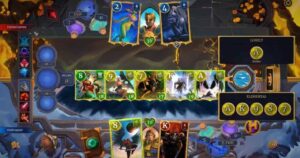Angry Birds isn’t done evolving. While the original slingshot formula has gone through countless iterations, Rovio’s next release, Angry Birds Bounce, is moving in a different direction—literally. This time, everything goes vertical, with a gameplay loop that leans more toward pinball than puzzle.
Set for release on mobile later this year, Bounce looks like a lightweight arcade spinoff, but under the surface, it’s a pretty focused experiment. It borrows from pachinko-style randomness and mixes it with progression systems that feel more in line with hypercasual mobile trends.
Vertical gameplay with light chaos
Instead of aiming at structures, players now launch birds into vertical levels filled with bumpers, walls, enemies, and item pickups. The idea is to maximize bounce potential while hitting targets and triggering effects, more like a high-speed ricochet puzzle than the destructible fortress model of older titles.
The pacing feels closer to an arcade game than a traditional level-based puzzler. Birds shoot up, bounce around, hit modifiers, and gradually unlock new paths. It’s reactive rather than strategic, with much of the challenge coming from managing chaos instead of planning shots.
Visuals and format stay accessible
Graphically, Bounce stays in familiar territory. Bright, cartoon-style characters, bold outlines, and fast feedback effects. It’s built to be digestible on small screens without clutter or slowdown. There’s no reinvention of the aesthetic, but it doesn’t really need one either.
The game is designed for short bursts. Everything from the level design to the UI is geared toward quick play sessions. You can see the influence of modern vertical scrollers and idle battlers in the way content is surfaced—fast, casual, and reward-driven.
Collection mechanics replace puzzles
Instead of solving levels by knocking over structures, the goal here is often tied to collecting items or hitting targets within a time limit. Progression comes through earning stars, unlocking new birds, and upgrading power-ups.
Some systems seem to echo gacha-style unlocks, though full monetization details aren’t confirmed yet. What’s clear is that progression won’t rely on precision puzzle solving, but on grinding through runs and improving your gear over time.
Familiar IP, new structure
This isn’t the first time Rovio has spun its main franchise into other genres. Angry Birds Transformers, Angry Birds Epic, and others have explored action, RPG, and more. But Bounce strips things back down to a core loop and leans into randomness and physics without much narrative dressing.
In that way, it’s closer to mobile arcade staples like Peggle Blast or Bouncemasters, just layered with familiar branding. It’s not trying to be deep, but it’s not pretending to be a mainline entry either.
A test of format flexibility
What’s interesting here isn’t the bird-throwing itself, but how Angry Birds keeps adapting to mobile trends without abandoning its base tone. With Bounce, Rovio seems more interested in fitting the format than reworking the franchise, and that might be the smartest play.
Whether this lands as a side-project or something that scales up into its own series will depend on how sticky the core loop feels once players get hands-on. But at the very least, it shows Rovio isn’t just relying on nostalgia—they’re still testing what else this brand can do.
Mobile Game Addict & Casual Gaming Critic
She’s played more mobile games than most people have downloaded. TAPTAPTAP is fast, fierce, and funny — reviewing the latest hypercasual hits, idle clickers, and gacha grinds with real talk and zero fluff.




